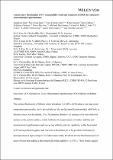Atomic layer fluorination of 5 V class positive electrode material LiCoPO4 for enhanced electrochemical performance
Abstract
The surface fluorination of lithium cobalt phosphate (LiCoPO4, LCP) using a one‐step, room temperature processable, easily up‐scalable and dry surface modification method with XeF2 as fluorine source was developed. After fluorination, fluorine‐rich nanoparticles were observed mainly on the particle surface, which facilitates the improvement of surface stability and electrochemical performance such as cycling stability and rate capability, as the fluorinated LCP can be protected against side reactions with electrolyte or by‐products of electrolyte decomposition at high voltage (5 V). More importantly, the direct surface fluorination proved more efficient than adding a fluorinated electrolyte additive (i. e., FEC). These results suggest that surface fluorination using XeF2 is of great promise for practical applications of high voltage positive materials for lithium‐ion batteries.
Citation
Kim , S , Kim , E J , Charles-Blin , Y , Guérin , K , Dubois , M , Flahaut , D , Martinez , H , Deschamps , M , Miller , D N , Irvine , J T S , Armstrong , R , Monconduit , L & Louvain , N 2020 , ' Atomic layer fluorination of 5 V class positive electrode material LiCoPO 4 for enhanced electrochemical performance ' , Batteries and Supercaps , vol. Early View . https://doi.org/10.1002/batt.202000041
Publication
Batteries and Supercaps
Status
Peer reviewed
ISSN
2566-6223Type
Journal article
Description
EJK would like to thank the Alistore ERI for the award of a studentship. The authors thank EPSRC Capital for Great Technologies Grant EP/L017008/1. The authors want to thank the French Research Network on the Electrochemical Energy Storage (RS2E) for YCB’s PhD grant. MD and NL are indebted to the IR-RMN-THC FR3050 CNRS for the spectrometer time access and the financial support of the NMR experiments.Collections
Items in the St Andrews Research Repository are protected by copyright, with all rights reserved, unless otherwise indicated.

